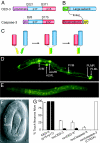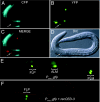Targeted cell killing by reconstituted caspases
- PMID: 17283333
- PMCID: PMC1892955
- DOI: 10.1073/pnas.0610877104
Targeted cell killing by reconstituted caspases
Erratum in
- Proc Natl Acad Sci U S A. 2008 Jan 15;105(2):824
Abstract
We have developed a two-component system involving reconstituted caspase (recCaspase) for selective and/or conditional ablation of targeted cells. Caspases, the executioners of programmed cell death, are normally synthesized as inactive zymogens and are activated by proteolytic processing of their subunits. We show here, using two different caspases, Caenorhabditis elegans CED-3 and human Caspase-3, that coexpression of the subunits generates constitutively active caspase activity that leads to cell death. This recCaspase activity, however, occurred only when the subunits associated through binding of linked antiparallel leucine-zipper domains. We exploited the dual-component nature of recCaspases by expressing the individual subunits from combinations of promoters either to target selectively the subset of cells for apoptosis or induce cell death in specific cells at specific times during development. The high degree of target specificity and tight regulation of induction of recCaspase would be advantageous in creating animal models that are ablated for specific cells and in other targeted cell killings.
Conflict of interest statement
Conflict of interest statement: D.S.C. has submitted a patent based on this work.
Figures




Similar articles
-
Timing of the onset of a developmental cell death is controlled by transcriptional induction of the C. elegans ced-3 caspase-encoding gene.Development. 2007 Apr;134(7):1357-68. doi: 10.1242/dev.02818. Epub 2007 Feb 28. Development. 2007. PMID: 17329362
-
Inhibition of the Caenorhabditis elegans cell-death protease CED-3 by a CED-3 cleavage site in baculovirus p35 protein.Nature. 1995 Sep 21;377(6546):248-51. doi: 10.1038/377248a0. Nature. 1995. PMID: 7675111
-
DRP-1-mediated mitochondrial fragmentation during EGL-1-induced cell death in C. elegans.Nature. 2005 Feb 17;433(7027):754-60. doi: 10.1038/nature03316. Nature. 2005. PMID: 15716954
-
Mitochondrial Cell Death Pathways in Caenorhabiditis elegans.Curr Top Dev Biol. 2015;114:43-65. doi: 10.1016/bs.ctdb.2015.07.019. Epub 2015 Sep 11. Curr Top Dev Biol. 2015. PMID: 26431563 Review.
-
Therapeutic opportunities based on caspase modulation.Semin Cell Dev Biol. 2018 Oct;82:150-157. doi: 10.1016/j.semcdb.2017.12.008. Epub 2017 Dec 15. Semin Cell Dev Biol. 2018. PMID: 29247787 Review.
Cited by
-
The transcription factor unc-130/FOXD3/4 contributes to the biphasic calcium response required to optimize avoidance behavior.Sci Rep. 2022 Feb 3;12(1):1907. doi: 10.1038/s41598-022-05942-0. Sci Rep. 2022. PMID: 35115609 Free PMC article.
-
Amphid sensory neurons of Caenorhabditis elegans orchestrate its survival from infection with broad classes of pathogens.Life Sci Alliance. 2023 May 31;6(8):e202301949. doi: 10.26508/lsa.202301949. Print 2023 Aug. Life Sci Alliance. 2023. PMID: 37258276 Free PMC article.
-
Enhanced neuronal RNAi in C. elegans using SID-1.Nat Methods. 2010 Jul;7(7):554-9. doi: 10.1038/nmeth.1463. Epub 2010 May 30. Nat Methods. 2010. PMID: 20512143 Free PMC article.
-
Dual Recombining-out System for Spatiotemporal Gene Expression in C. elegans.iScience. 2020 Sep 15;23(10):101567. doi: 10.1016/j.isci.2020.101567. eCollection 2020 Oct 23. iScience. 2020. PMID: 33083734 Free PMC article.
-
Regulation of two motor patterns enables the gradual adjustment of locomotion strategy in Caenorhabditis elegans.Elife. 2016 May 25;5:e14116. doi: 10.7554/eLife.14116. Elife. 2016. PMID: 27222228 Free PMC article.
References
Publication types
MeSH terms
Substances
Grants and funding
LinkOut - more resources
Full Text Sources
Other Literature Sources
Molecular Biology Databases
Research Materials

